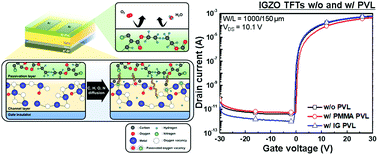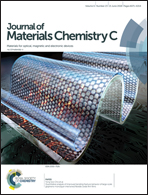A selectively processible instant glue passivation layer for indium gallium zinc oxide thin-film transistors fabricated at low temperature†
Abstract
In this research article, instant glue (IG) is proposed as a novel material for the passivation layer of indium–gallium–zinc oxide (IGZO) thin-film transistors (TFTs). This material can be deposited using a facile solution process and annealed at a low temperature of 150 °C for 1 min. The IGZO TFTs with an IG passivation layer (PVL) exhibit improved electrical characteristics as well as stability under positive bias stress compared to those without a PVL: field effect mobility from 10.23 to 12.66 cm2 V−1 s−1, subthreshold swing from 0.36 to 0.35 V per decade, on/off ratio from 1.6 × 108 to 5.21 × 108, and threshold voltage shift from 4.00 to 2.32 V. These improvements are attributed to the modification of the chemical stoichiometry of the IGZO films and the blocking of the adsorption of moisture and oxygen. Furthermore, by depositing IG materials selectively on IGZO films via the drop casting method, it was confirmed that an IG PVL can be fabricated at the desired location as well as in a large area due to the high adhesive strength and viscosity of IG.



 Please wait while we load your content...
Please wait while we load your content...